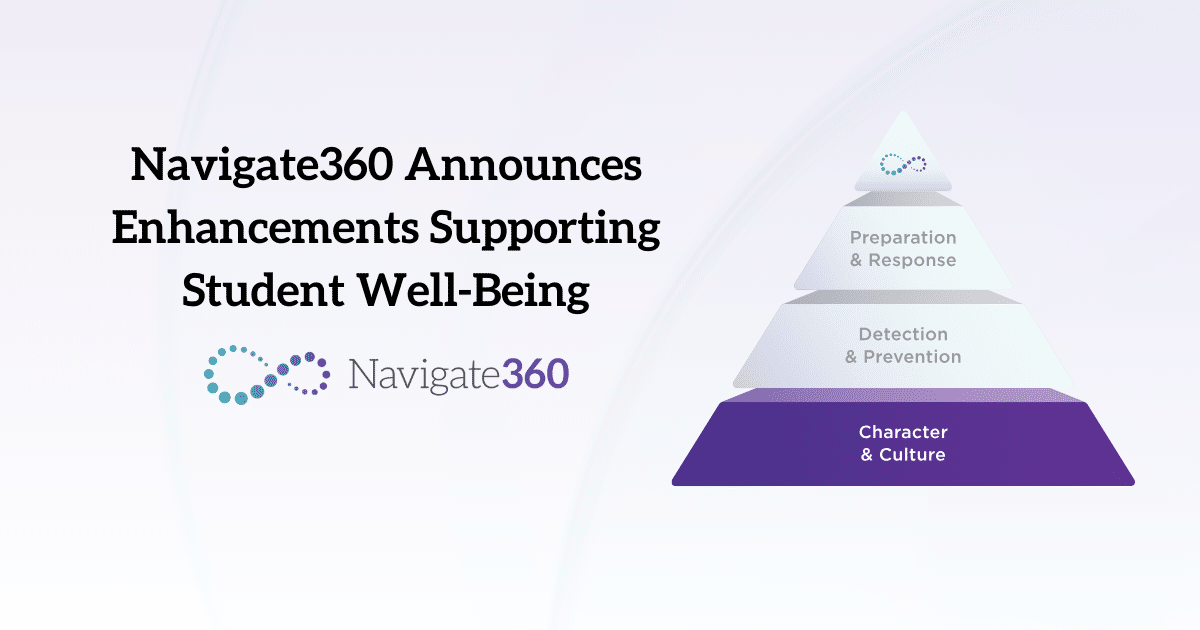The importance of youth suicide prevention cannot be understated. According to the Centers for Disease Control & Prevention (CDC), the second leading cause of death among adolescents is suicide. While this is a shocking statistic, it’s not likely to surprise school-age kids. In a survey conducted by Navigate360 and John Zogby Strategies in March 2021, 59% of teens said they knew of someone who had considered self-harm or suicide. That’s an increase of three percentage points from the same survey conducted in January. As we confront these alarming figures, the importance of schools prioritizing youth suicide prevention and awareness becomes clear.
In this blog, we delve into the crucial nature of youth suicide prevention and how schools can play a pivotal role in safeguarding the well-being of our younger generation. We’ll explore the proactive measures, strategies, and support systems that can make a tangible difference in the lives of our youth, underscoring the importance of collective action and community involvement.
Why Schools Need to Be Involved in Youth Suicide Prevention
Youth suicide rates will improve only if there is a collective effort from everyone who interacts with adolescents. Of course, schools have an essential role to play. After all, a substantial part of an adolescent’s life is spent at school: In a single year, half of their time will be spent at school, which means educators, counselors, administrators, and other school staff often interact with students just as much as their family members, friends, and community leaders.
Because of the alarming rise in suicide and self-harm ideation, it is incumbent upon schools to implement a comprehensive youth suicide prevention program. In doing so, school personnel can develop a deeper understanding of suicide warning signs, enabling them to provide the right strategies and interventions to help their students. This creates a supportive, encouraging, and proactive environment for students in which their mental health needs are considered as vital to their success as their academic needs are.
Unfortunately, most students don’t feel as if their schools have the resources to address their mental health needs. In that same Navigate360/Zogby survey, just 23% of students believe their schools can provide help for mental health concerns (while 62% of parents thought the opposite). This illustrates the divide between children and their parents. In fact, in that same survey, 38% of parents reported they never discuss mental health issues with their children. This indicates the critical need for school districts to implement holistic, comprehensive youth suicide prevention programs that include partnerships with both parents and the community.
Building a Partnership Among Parents, Community Leaders & Schools
Implementing a districtwide suicide prevention program takes the support and participation not only of school personnel but also of parents and community leaders. There should be a continuous flow of information and resources from schools to students’ homes and into the community. After all, while students spend half of the school year in the classroom, they spend the other half — and school breaks — at home and involved in community-based activities like extracurricular sports. This means that parents and community leaders have an essential role to play in preventing youth suicide and providing mental health support for children.
Including parents and the community in your youth suicide prevention program can involve:
- Regular trainings – Conduct trainings with parents and community leaders that not only address youth suicide warning signs but also discuss how to talk about mental health with children. Children who feel they can honestly communicate their complex emotions with their parents and other adults grow up to better understand their mental health and know how to reach out for help when things feel difficult.
- Clear communication – Let parents into the process of your suicide prevention program by providing regular updates on any new strategies or processes your school district is implementing. All parents should understand exactly how your program works and everything it entails, including intervention methods.
When schools join forces with parents and the community, students begin to hear a consistent message of support and encouragement, from the home to the classroom and beyond.
Implementing a Holistic Youth Suicide Prevention Program
A holistic suicide prevention program brings together a variety of key features that help to ensure open lines of communication between students and faculty. In addition, it offers comprehensive support for school personnel so they understand how to identify suicide risk and the intervention process to follow. The program should include:
- Ongoing education so school staff can effectively identify the warnings signs of suicide, conduct suicide screenings, work through the intervention process with students, and discuss a student’s suicide risk with parents
- Anonymous tip reporting that provides a safe, trusted place to report concerning behaviors such as threats or suicide risk
- Ethical digital scanning technology that empowers schools to proactively identify harmful intent before it happens
- Behavioral threat assessments and case management processes that provide accurate, evidence-based suicide risk screenings and appropriate interventions based on thorough evaluations
Suicide Awareness & Prevention with Navigate360
Schools have a crucial role to play in providing mental health support and youth suicide awareness and prevention strategies for their students. Youth suicide rates will improve only if schools get involved. Creating a culture of safety, support and inclusion ensures that students enjoy an encouraging environment in which they can succeed emotionally, mentally and academically. That should be the goal of every school district.
Navigate360 is building a full suite of preventive safety solutions aimed at helping school districts create a comprehensive, holistic suicide prevention program. We’ve partnered with Scott Poland, Ed.D, an internationally recognized expert of youth suicide prevention and school safety, to develop this eLearning and training program. Dr. Poland has co-authored resources such as the Suicide Safer Schools plan for Texas school districts and the Crisis Action School Toolkit-Suicide for Montana school districts. His expertise ensures a robust, comprehensive suicide prevention program for school districts nationwide.
Navigate360’s research-based program includes anonymous tip reporting, ethical digital scanning technology, suicide risk screening and behavioral threats assessments, and suicide awareness and prevention education. Your school district can manage every case using our Behavioral Threat Assessment Case Manager with suicide risk screening and management that offers:
- Automated reminders and task assignments to ensure school personnel always know what to do when an intervention is needed
- An easy-to-use interface that allows for collaboration with other schools, outside agencies and more
- A simple way to ensure everyone in your school district is aligned on best practices to provide a consistent process for students
- A suicide risk screening and management feature that allows schools to utilize nationally recognized suicide risk assessment models — the Columbia Suicide Severity Rating Scale (C-SSRS), which is designed for use by anyone, anywhere, and the Suicide Assessment Five-Step Evaluation and Triage (SAFE-T) for clinicians — to evaluate student suicide risk and provide guidance on immediate intervention steps
To learn more about implementing a youth suicide awareness and prevention program in your school district with Navigate360, contact us today.
If you or someone you know might be at risk of suicide, call the National Suicide Prevention Lifeline at 800-273-8255 or visit their website for additional information. You can also text HOME to 741741 to connect with the Crisis Text Line.
Navigate360 School Culture & Climate Solutions
Your Guide to All-Encompassing Mental Health & Wellness in Your District
Youth mental health has been declared a national emergency by pediatric associations as well as the U.S. Surgeon General. This growing issue is putting more pressure than ever on school leaders to respond and protect students in crisis before issues escalate, but they often lack the resources and training needed to do so successfully.
School Culture & Climate solutions from Navigate360 help you proactively address concerning behaviors while providing support to those students in crisis.




